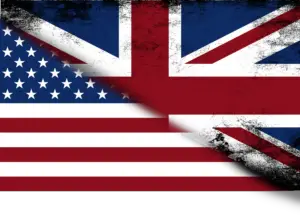Understanding the Differences Between American and British Business English
 As a global language, English is spoken by millions of people all around the world. However, the way in which English is spoken can vary greatly depending on the region. Two of the most prominent variations of British (UK) English and American (US) English. These two forms of the language differ not only in their accents but also in their vocabulary, spelling and grammar, which can pose challenges for businesses operating in both regions.
As a global language, English is spoken by millions of people all around the world. However, the way in which English is spoken can vary greatly depending on the region. Two of the most prominent variations of British (UK) English and American (US) English. These two forms of the language differ not only in their accents but also in their vocabulary, spelling and grammar, which can pose challenges for businesses operating in both regions.
In this article, we will discuss the main differences between American and British Business English.
Vocabulary Differences
One of the most notable differences between American and British business English is their vocabulary.
While many words are used interchangeably in both variations of the language, there are a number of words that are unique to each region. For instance, in British English, a “biscuit” refers to what Americans call a “cookie,” while in American English, a “biscuit” is a type of bread roll. Similarly, in American English, a “truck” is what British people refer to as a “lorry” and a “elevator” is known as a “lift.”
These differences in vocabulary can create confusion and misunderstandings in business settings, especially when negotiating contracts or discussing specific details. Therefore, it is important for businesses to be aware of the key vocabulary differences between American and British English in order to communicate effectively with clients, suppliers and other stakeholders.
This table shows some common words that differ between the two variants. It should give you an idea of the scope of the ‘problem’.
| British English | American English |
|---|---|
| Flat | Apartment |
| Lift | Elevator |
| Biscuit | Cookie |
| Queue | Line |
| Torch | Flashlight |
| Petrol | Gasoline |
| Trousers | Pants |
| Jumper | Sweater |
| Car park | Parking lot |
| Chips | French fries |
| Crisps | Potato chips |
| Aubergine | Eggplant |
| Courgette | Zucchini |
| Sweets | Candy |
| Mobile phone | Cell phone |
| Pavement | Sidewalk |
| Rubbish | Garbage |
| Bonnet | Hood |
| Boot | Trunk |
| Postcode | Zip code |
| Hoover | Vacuum |
| Trolley | Cart |
| Nappy | Diaper |
| Cot | Crib |
| Trainer | Sneaker |
| Jelly | Jello |
| Bill | Check |
This is nothing near an exhaustive list and there may be regional variations or differences in usage within both British and American English, especially in business contexts.
Spelling Differences
In addition to differences in vocabulary, American and British business English also differ in their spelling.
While many words are spelled the same way in both variations of the language, there are some words that are spelled differently. For example, in American English, the word “color” is spelled without a “u,” while in British English, it is spelled “colour.” Similarly, in American English, the word “center” is spelled without an “re,” while in British English, it is spelled “centre.”
Other changes involve replacing “ise” with “ize” and generally making certain spellings more phonetic (the UK “plough” becomes “plow” in the US, for example).
These differences in spelling may seem minor, but they can still cause confusion and errors in business communications, particularly when working on documents that will be distributed internationally. Therefore, it is important for businesses to be aware of the key spelling differences between American and British English in order to ensure consistency and accuracy in their communications.
The history behind this is interesting. When Noah Webster started creating his American Dictionary of the English Language, the US had just finished a war of independence with Great Britain. He used this opportunity to show a sense of new identity and deliberately made some things different. There is no linguistic reasoning for any of these changes – it was done just to be different.
This table shows some common words that have slight spelling changes between UK and US English.
| British English | American English |
|---|---|
| Colour | Color |
| Centre | Center |
| Theatre | Theater |
| Licence | License |
| Defence | Defense |
| Travelling | Traveling |
| Jewellery | Jewelry |
| Plough | Plow |
| Programme | Program |
| Catalogue | Catalog |
| Pyjamas | Pajamas |
| Grey | Gray |
| Aluminium | Aluminum |
| Favour | Favor |
| Honour | Honor |
| Humour | Humor |
| Neighbour | Neighbor |
| Organisation | Organization |
| Practice | Practise |
| Tyre | Tire |
| Fibre | Fiber |
| Dialogue | Dialog |
| Analyse | Analyze |
| Axe | Ax |
| Paediatric | Pediatric |
| Anaemia | Anemia |
| Oestrogen | Estrogen |
This is nothing near an exhaustive list!
Grammar Differences
In addition to vocabulary and spelling differences, another significant difference between American and British business English is grammar.
While the basic rules of grammar are similar in both variations of the language, there are some key differences in terms of usage and style. For example, in American English, it is common to use the past tense of “get” as “gotten,” while in British English, the past tense is “got” and the past participle is “gotten”.
A further example is the verb “to sneak”. In UK English, “to sneak” is regular (sneak, sneaked, sneaked) but for US English, it’s an irregular verb (sneak, snuck, snuck).
Additionally, in American English, it is common to use the present perfect tense with the word “just” to indicate recent events, while in British English, the past simple tense is often used instead.
Examples:
- I’ve just seen Sally.
- I just saw Sally.
These differences in grammar can also cause confusion and misunderstandings in business settings, particularly when writing formal documents such as reports or proposals. Therefore, it is important for businesses to be aware of the key grammar differences between American and British English in order to avoid errors and convey their intended message clearly.
If you’re interested in learning more about grammar, you should check out this post, that gives details of my grammar course on Udemy. The differences between UK and US English are highlighted where necessary throughout the whole course.
Punctuation Differences
Related to grammar, there are important punctuation changes to consider.
There are two main differences, namely commas in lists and abbreviations.
Commas in Lists
In UK English, there is no comma before the ‘and’ or ‘or’ in a list of items. In US English, there is a comma there.
Examples:
- We went shopping and bought apples, oranges and bananas.
- We went shopping and bought apples, oranges, and bananas.
Common Abbreviations
Usually, when we have abbreviations, we use a full stop (.) to show this, as in etc. being short for etcetera.
In UK English, for certain common abbreviations, such as Mr, Mrs and Dr, the full stop is omitted and the abbreviation is treated like a ‘normal’ word. In US English, the full stop (or period, as they would call it) is retained.
Examples:
- I have an appointment with Dr Brown.
- I have an appointment with Dr. Brown.
This is important for business communication as the salutation often involves one of the abbreviations mentioned.
For a great course about professional emails, please check out my Udemy course on exactly this topic. It’s called “Business English – Write Professional Emails in English“. The link also includes a promotional discount.
American and British Business English – Summary
In conclusion, while American and British business English are both variations of the English language, there are significant differences between the two in terms of vocabulary, grammar and spelling.
These differences can create challenges for businesses operating in both regions, but by being aware of these differences and taking steps to ensure clear communication, businesses can overcome these challenges and succeed in both the American and British markets.


